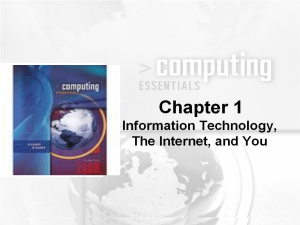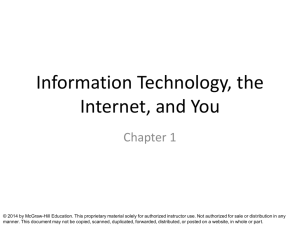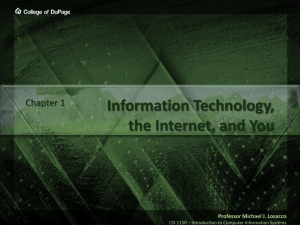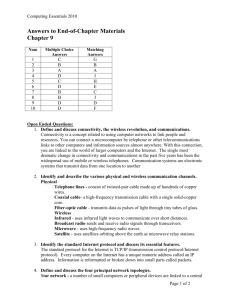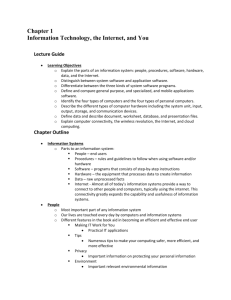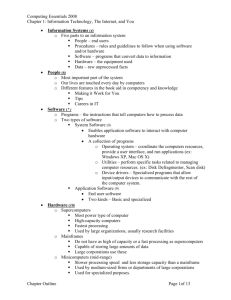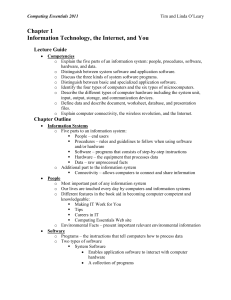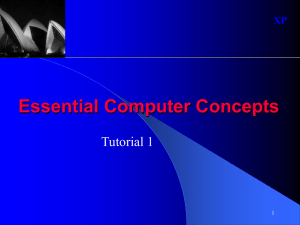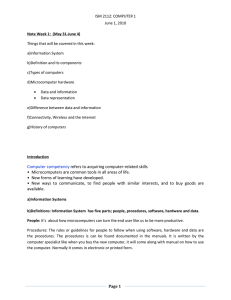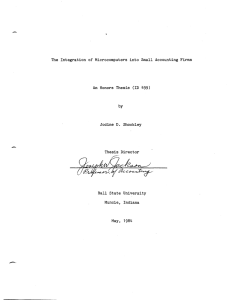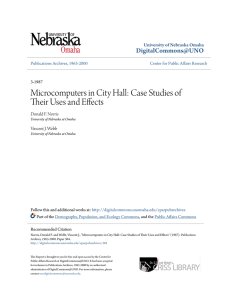1-2
advertisement
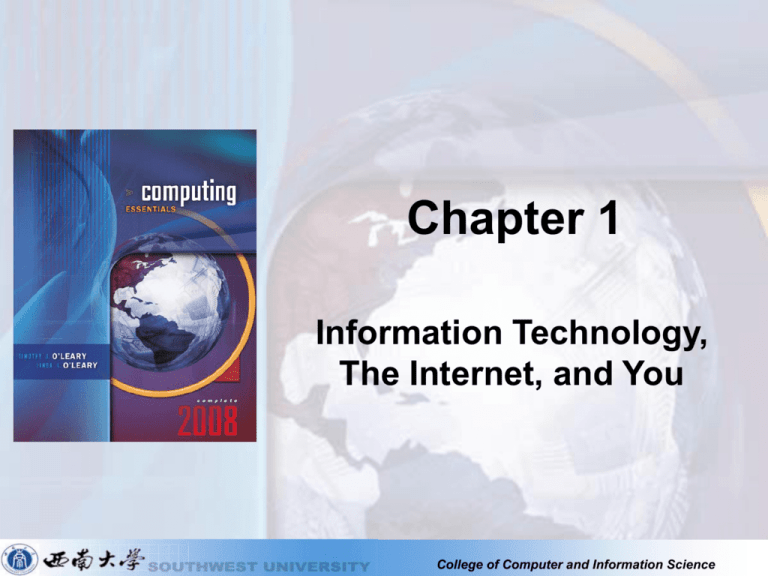
Chapter 1 Information Technology, The Internet, and You College of Computer and Information Science Key Words & Terms • • • • • • • • • • • • • application software: 应用软件 basic application: 基本应用软件 communication device: 通讯设备 compact disc(CD): 紧凑格式盘 computer competency: 计算机技能 connectivity: 连通, 连通性 data: 数据 database file: 数据库文件 desktop computer: 台式计算机 digital versatile (video) disc: DVD, 数字式通用盘 document file: 文档文件 end user: 终端用户 floppy disk: 软盘 College of Computer and Information Science 1-2 Key Words & Terms • • • • • • • • • • • • • • handheld computer: 手提电脑 hard disk: 硬盘 hardware: 硬件 high definition (hi def): 高清(高清晰度) information: 信息 information system: 信息系统 information technology (IT) : 信息技术 input device: 输入设备 Internet: 互联网 keyboard: 键盘 mainframe computer: 大型机 memory: 内存 microcomputer: 微型计算机 microprocessor: 微处理器 College of Computer and Information Science 1-3 Key Words & Terms • • • • • • • • • • • • • • • midrange computer: 中型机 minicomputer: 小型机 modem (modulator & demodulator): 调制解调器 monitor: 监视器 mouse: 鼠标 network: 网络 notebook computer: 笔记本电脑 operating system (OS): 操作系统 optical disk: 光盘 output device: 输出设备 palm computer: 掌上电脑 personal digital assistant (PDA): 个人数字化助理 presentation file: 演示文稿 primary storage: 主存 printer: 打印机 College of Computer and Information Science 1-4 Key Words & Terms • • • • • • • • • • • • • • procedures: 过程/用户文档 program: 程序 random access memory (RAM): 可读写内存 secondary storage device: 辅助存储设备 software: 软件 specialized application: 专用应用软件 supercomputer: 超级计算机 system software: 系统软件 system unit: 系统单元 tablet PC: 带手写板的笔记本电脑 utility: 工具软件 Web: 网 wireless revolution: 无线(通讯)革命 worksheet file: 工作表文件 College of Computer and Information Science 1-5 Competencies (Page 1 of 2) • Explain the five parts of an information system: people, procedures, software, hardware, and data. • Distinguish between system software and application software. • Discuss the three kinds of system software programs. • Distinguish between basic and specialized application software. • Identify the four types of computers and the four type of microcomputers. Page 2 College of Computer and Information Science 1-6 Competencies (Page 2 of 2) • Describe the different types of computer hardware including the system unit, input, output, storage, and communication devices. • Define data and describe document, worksheet, database, and presentation files. • Explain computer connectivity, the wireless revolution, and the Internet. Page 2 College of Computer and Information Science 1-7 Introduction • Computer competency refers to acquiring computerrelated skills • Microcomputers are common tools in all areas of life • New forms of learning have developed • New ways to communicate, to find people with similar interests, and to buy goods are available. Page 3 College of Computer and Information Science 1-8 Five Parts of an Information System 1. People 2. Procedures 3. Software Page 4 4. Hardware 5. Data College of Computer and Information Science 1-9 People • Most important part of any system • Contact is … – Direct – Indirect • Computer uses – Business & Entertainment – Education & Medicine Page 6 College of Computer and Information Science 1-10 Software • AKA Programs • Two major kinds of software – System Software – Application Software Page 7 College of Computer and Information Science 1-11 Hardware - Types of Computers • Supercomputers • Mainframe computers • Minicomputers (also known as mid-range computers) • Microcomputers Page 10 College of Computer and Information Science 1-14 Microcomputer Types • Desktop • Notebook or laptop • Tablet PC • Handheld Page 11 College of Computer and Information Science 1-15 Microcomputer Hardware • Four basic categories of equipment: – System Unit – Input/Output – Secondary Storage – Communication Page 11 College of Computer and Information Science 1-20 System Unit • Two important components – Microprocessor – Memory Return Page 12 College of Computer and Information Science 1-21 Input/Output Devices • Common input devices are the keyboard and the mouse • Common output devices are printers and monitors Return Page 12 College of Computer and Information Science 1-22 Secondary Storage • Unlike memory, secondary storage holds data and programs even if electrical power is not available • The most important types of secondary media are floppy, hard, and optical disks Return Page 13 College of Computer and Information Science 1-23 Communications • Communication Devices provide microcomputers with the ability to communicate with other computer systems across the globe • The modem is the most widely used communication device • Modems modify telephone communications into a form that can be processed by a computer • Modems also modify computer output into a form that can be transmitted across standard telephone lines Page 13 College of Computer and Information Science 1-24 Data • Raw, unprocessed facts • Processed data becomes information • Stored electronically in files – Document files – Worksheet files – Database files – Presentation files Page 14 College of Computer and Information Science 1-25 Connectivity, the Wireless Revolution, and the Internet • Connectivity – Sharing of information – Wireless communication is becoming popular • Computer networks – Connected communication system of computers – Largest network is the Internet Page 15 College of Computer and Information Science 1-30 Careers In IT • For a complete listing of careers, visit www.computing2008.com keyword: careers Page 16 College of Computer and Information Science 1-31 Discussion Questions (Page 1 of 2) • Explain the five parts of an information system. What part do people play in this system? • What is system software? What kinds of programs are included in system software? • Define and compare basic and specialized application software. Describe some different types of basic applications. Describe some types of specialized applications. Page 24 College of Computer and Information Science 1-32 Discussion Questions (Page 2 of 2) • Describe the different types of computers. What is the most common type? What are the types of microcomputers? • What is connectivity? How are the wireless revolution and connectivity related? What is a computer network? What is the Internet? What is the Web? Page 24 College of Computer and Information Science 1-33 The End of Chapter 1 College of Computer and Information Science 1-34
